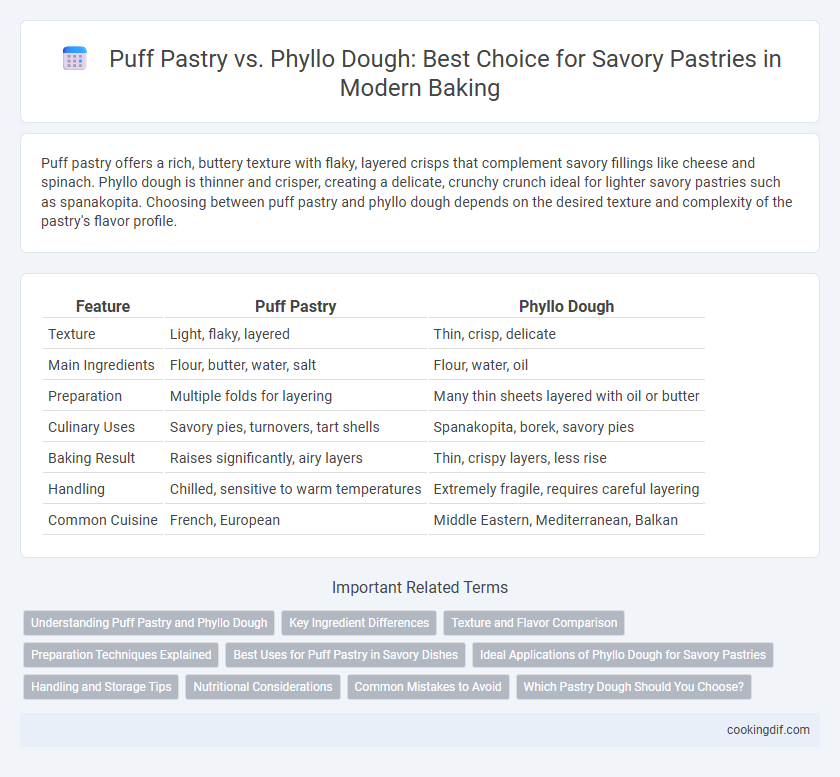Puff pastry offers a rich, buttery texture with flaky, layered crisps that complement savory fillings like cheese and spinach. Phyllo dough is thinner and crisper, creating a delicate, crunchy crunch ideal for lighter savory pastries such as spanakopita. Choosing between puff pastry and phyllo dough depends on the desired texture and complexity of the pastry's flavor profile.
Table of Comparison
| Feature | Puff Pastry | Phyllo Dough |
|---|---|---|
| Texture | Light, flaky, layered | Thin, crisp, delicate |
| Main Ingredients | Flour, butter, water, salt | Flour, water, oil |
| Preparation | Multiple folds for layering | Many thin sheets layered with oil or butter |
| Culinary Uses | Savory pies, turnovers, tart shells | Spanakopita, borek, savory pies |
| Baking Result | Raises significantly, airy layers | Thin, crispy layers, less rise |
| Handling | Chilled, sensitive to warm temperatures | Extremely fragile, requires careful layering |
| Common Cuisine | French, European | Middle Eastern, Mediterranean, Balkan |
Understanding Puff Pastry and Phyllo Dough
Puff pastry consists of multiple layers of dough and butter, creating a flaky, airy texture ideal for savory pastries requiring structural integrity and rich flavor. Phyllo dough is made of paper-thin sheets brushed with oil or butter, producing a crisp, delicate layer suited for lighter fillings and a contrasting crunch. Choosing between puff pastry and phyllo dough depends on the desired texture and complexity in savory pastry preparations.
Key Ingredient Differences
Puff pastry relies on layers of butter and dough, creating a flaky texture through steam generated during baking, while phyllo dough consists of thin, unleavened sheets brushed with oil or butter, resulting in a crisp and delicate finish. Puff pastry ingredients typically include flour, butter, water, and salt, whereas phyllo dough primarily uses flour, water, and a small amount of vinegar or lemon juice without butter. The higher fat content in puff pastry contributes to its rise and flakiness, contrasting with phyllo's paper-thin layers that provide a light, crispy structure ideal for savory pastries like spanakopita.
Texture and Flavor Comparison
Puff pastry offers a rich, buttery flavor with a light, flaky texture created by its multiple layers of dough and butter. Phyllo dough provides a much thinner, crispier texture with a more neutral taste, allowing fillings to dominate the flavor profile. For savory pastries, puff pastry delivers a more indulgent mouthfeel, while phyllo gives a delicate crunch that enhances artisanal fillings.
Preparation Techniques Explained
Puff pastry involves repeatedly folding and rolling dough layered with butter to create a flaky, airy texture through steam expansion during baking, while phyllo dough consists of ultra-thin sheets brushed with melted butter or oil and stacked to achieve a crisp, delicate finish. Puff pastry requires precise temperature control and resting periods to maintain distinct layers, whereas phyllo demands careful handling to prevent tearing and quick assembly to retain moisture balance. Both methods emphasize technique, but puff pastry relies on lamination for rise, whereas phyllo depends on layering for crispness in savory pastries.
Best Uses for Puff Pastry in Savory Dishes
Puff pastry is ideal for savory dishes requiring a light, flaky texture and rich buttery flavor, such as beef Wellington, sausage rolls, or pot pies. Its multiple layers create an impressive rise and tenderness that phyllo dough, with its thin, crisp sheets, cannot replicate in hearty fillings. Puff pastry's versatility in wrapping and topping savory ingredients makes it the preferred choice for indulgent, flaky pastries with substantial fillings.
Ideal Applications of Phyllo Dough for Savory Pastries
Phyllo dough excels in savory pastries that require thin, crisp layers such as spanakopita and borek, where its delicate texture contrasts with rich fillings like spinach, cheese, or ground meat. Its versatility allows for easy shaping into triangles, rolls, or layered pies, enhancing both visual appeal and mouthfeel. The low-fat nature of phyllo dough also makes it ideal for lighter savory dishes compared to the richer, flakier puff pastry.
Handling and Storage Tips
Puff pastry requires careful handling to maintain its layers and should be kept cold to prevent the butter from melting, ensuring optimal flakiness in savory pastries. Phyllo dough is delicate and needs to be kept covered with a damp cloth during preparation to prevent drying and tearing, with unused sheets best stored wrapped tightly in plastic and refrigerated. Both dough types benefit from freezing if longer storage is needed, but puff pastry must be thawed slowly while phyllo dough requires gentle handling when thawed.
Nutritional Considerations
Puff pastry contains higher fat content due to its multiple layers of butter, resulting in richer calories and saturated fats, whereas phyllo dough offers a lighter alternative with significantly lower fat and calorie levels, making it more suitable for health-conscious diets. Phyllo's thin, unleavened layers provide a crispy texture with minimal oil usage, contributing to reduced cholesterol and overall healthier nutritional profiles in savory pastries. When choosing between the two for savory dishes, phyllo dough supports lower fat intake, while puff pastry enhances flavor and richness but demands moderation due to its denser caloric and fat content.
Common Mistakes to Avoid
Using puff pastry for savory pastries often involves the mistake of overhandling the dough, which can cause it to lose its characteristic flakiness. Phyllo dough requires careful layering and brushing with butter or oil to prevent dryness and tearing, common errors that compromise texture and flavor. Avoiding these mistakes ensures the perfect crispy and light structure essential for delicious savory pastries.
Which Pastry Dough Should You Choose?
Puff pastry offers rich, flaky layers created by folding butter into dough, making it ideal for buttery, tender savory pastries such as vol-au-vents and meat pies. Phyllo dough consists of ultra-thin sheets brushed with oil or butter, resulting in a crisp, delicate texture perfect for layered dishes like spanakopita or borek. Choose puff pastry for a light, buttery bite with substantial rise, while phyllo provides a lightweight, crunchy finish suited for intricate, multi-layered savory recipes.
Puff pastry vs phyllo dough for savory pastries Infographic

 cookingdif.com
cookingdif.com